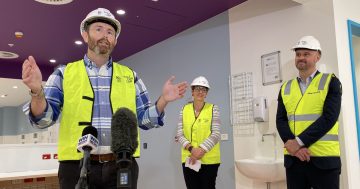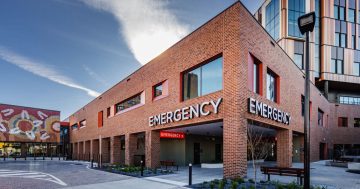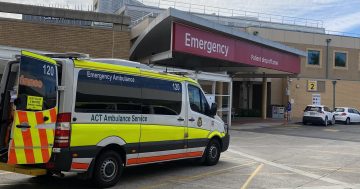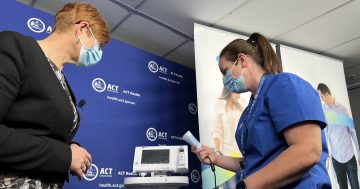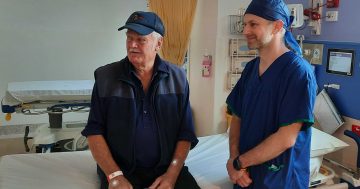
A number of initiatives have been implemented at both Canberra Hospital (pictured) and North Canberra Hospital emergency departments to improve wait times. Photo: Claire Fenwicke.
The Digital Health Record (DHR) system has been credited as a driving force in improving Canberra’s emergency department (ED) wait times across the board.
However, health officials admit there’s still a way to go to hit its targets.
While comparing the ACT to other jurisdictions can be like comparing apples with oranges, it has gone from having the worst ED wait times in the country to being in the middle of the pack.
According to 2022-23 data from the Australian Institute of Health and Welfare (AIHW), 51 per cent of the ACT’s ED patients were seen on time, up from 48 per cent in 2021-22.
That’s compared to 74 per cent in NSW and 65 per cent across Australia.
The average wait time for 50 per cent of patients was 36 minutes (down from 47 minutes the previous financial year), while 90 per cent of patients were seen within 191 minutes (down from 203 minutes).
That’s in contrast to the NSW and Australian averages, which both went up. The national average wait time for 50 per cent of patients was 20 minutes, and 124 minutes for 90 per cent of patients.
Canberra Hospital ED clinical director Dr Sam Scanlan said that there had been some improvements for his hospital, but he wouldn’t describe them as “game-changing” just yet.
“We still have a way to go to get to where we want those times to be,” he said.
“I’m confident, especially with what we’ve had happening in the past six months, this will lead to improved waiting times next year.”
Canberra Hospital has been implementing a number of changes to its ED to cut wait times and improve patient experience.
While ED patients only make up about 20 per cent of admissions to Canberra Hospital, they account for 60 per cent of the medical staff’s workload.
Dr Scanlan said the most significant change since November 2022 was the introduction of the DHR.
“The DHR has meant we can record events when we start treatment more effectively and communicate more efficiently,” he said.
“Previously, each system required a separate log-in … now a task that previously would have taken me 15 minutes is only taking me five minutes.”
Other initiatives have included increasing the capacity of the short-stay emergency medical unit and acute medical unit, changes in the mental health space to improve the flow of patients to treatment or a bed, along with efforts to recruit and retain nursing staff, the introduction of an ED medical navigator role and introduced advanced practice nurses to work in the fast-track area of the ED with a focus on semi-urgent and non-urgent patients.
Dr Scanlan also credited the leadership at Canberra Hospital for ongoing improvements.
“Not always do hospital executives understand that to improve the ED you have to improve things across the whole hospital,” he said.
“We’ve had really strong support to start to improve efficiencies.”
As for North Canberra Hospital, there has been increased access to theatres and emergency services, an expansion of allied health services inside and outside of the ED, improved bed management and escalation processes if there are bed and staff shortages, the introduction of 24/7 medical imaging services, restored capacity in the short stay unit, expanded nurse-initiated pathology and imaging, and enhanced use of nurse practitioners in the ED.
Both hospitals have implemented rapid review processes for any patient staying longer than 24 hours, improved communication processes within and outside the ED teams, and using clinical data from DHR for greater visibility of patient flow through the system and to see the capacity of clinical units.
Dr Scanlan wants further improvement, again pointing to the DHR as a key factor in making those numbers even better for the next reporting period.
“We’re probably about one-and-a-half years away from recognising the full potential of the DHR,” he said.
It’s expected the ED’s move to its new location in August next year will prove beneficial, with more capacity and the commencement of improved models of care.
“I’m hoping this will improve the wait times in the ED even further,” Dr Scanlan said.
“One year of performance improvement is good, but it needs to be sustained and keep heading in an upward trajectory.”













